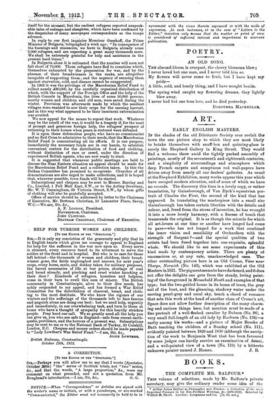ART.
EARLY ENGLISH MASTERS.
Ir the shades of the old Dilettante Society ever revisit the town the one picture shop to which they are most likely to betake themselves with snuff-box and quizzing-glass is• surely the Shepherd Gallery in King Street. They would- find a welcome there amid the tightly packed assembly of paintings, mostly of the seventeenth and eighteenth centuries, and a 'simplicity of surroundings and atmosphere which deep French carpets and sumptuous red wall-papers have driven away from nearly all our dealers' galleries. As usual.
at the Shepherd Exhibition, many works appear this year which have escaped modern attention, and of some of which we have no records. The discovery this time is a lovely copy, or rather translation, by Gaiusborough, of Van Dyck's equestrian por- trait of Charles the First, the second of the kind that has appeared. In translating the masterpiece into a small size
G Hillsborough has taken certain liberties with the details and colour, and, freed from the stress of invention, he has wrought
it into a more lovely harmony, with a finesse of touch that transcends the original. It is as though the miracle for which- all art-lovers at one time or another have longed had come to pass—who has not longed for a work that combined the inner vision and sensibility of Orchardson with the- strength of Sargent ?—and the special qualities of two artists had been fused together into one exquisite, splendid whole. We -should like to see some experiments of this kind made by contemporary artists. There are plenty of unconscious or, at any rate, unacknowledged ones. The' other outstanding picture here is an Old Crome, View near Thorpe, Norwich (No. 143), which was exhibited at the Old Masters in LS21. The pi g ment seems to ha:ve darkened, and it does not offer the delights one gets from the steady, loving paint- ing of the foreground in Mousehold Heath and examples of that type; but the two-gabled house in its home of trees, the grey sail of the boat, and the gleaming, shadowy water under the moving pearl-grey and coral sky, touch a chord of romance that sets this work at the head of another class of Crome's art, Space does not allow further description of the many charm- ing and curious things here, but mention must be made of a fine portrait of a well-fleshed cavalier by Dobson (No. 96), a very small full-length of an old lady by Raeburn (No. 134)—a
rarity among his works—and a picture of Major Brooke of Bath teaching the children of a Sunday school (No. 111),. evidently painted between 1820 and 1830 (although the ascrip-. Lion of the work to Benjamin West' that has been favoured by some judges can hardly survive an examination of dates), and a well-painted view of a town (No. 110) by a hitherto
unknown painter named J. Hamer. J. B.


























































 Previous page
Previous page